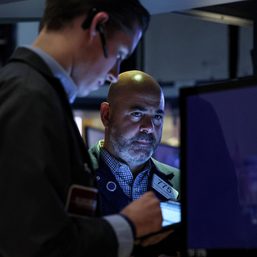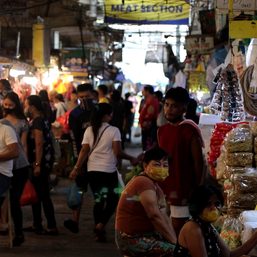SUMMARY
This is AI generated summarization, which may have errors. For context, always refer to the full article.
![[Vantage Point] The Filipinos’ shrinking pockets](https://www.rappler.com/tachyon/2022/10/Vantage-Point-shrinking-pocket-October-8-2022.jpg)
Except maybe for some 433 extremely lucky Filipinos who won the P239-million grand lotto jackpot on October 1, majority of us are finding it more difficult every day to draw from our shallow pockets just to make ends meet. Those lucky bettors who received P500,000 each have at least boosted their purchasing power for the next few months or so, depending on their respective spending habits.
Former senator Kiko Pangilinan couldn’t help but draw a price comparison between some of our kitchen essentials, such as garlic and onion, with those sold in Thailand’s public markets. A kilo of garlic in Bangkok costs 50 baht or P85 while Manila consumers have to shell out P400 for a kilo. A kilo of onion there that could be bought at 35 baht or P60 fetches P300 per kilo here.
In his Facebook post, Pangilinan also decries the fact that Thailand and Vietnam seem to handle better the inflationary effect of the foreign exchange crisis, despite having lower agricultural budgets. The Philippine agriculture budget of P102.5 billion, he infers, is two times and three times higher than that of Thailand and Vietnam, respectively.
Pangilinan is not alone in expressing dismay at how ineffective the government has been in handling the inflationary effects of a muscular US dollar. If we go by the latest Pulse Asia survey, majority of Filipinos (nearly 7 out of 10) are having sleepless nights over the soaring prices of basic goods and commodities.
At least for now, inflation appears to be President Ferdinand Marcos Jr.’s Waterloo. He was graded poorly by 1,200 Pulse Asia respondents who were surveyed between September 17 and 21.
For 60% of the respondents, controlling inflation was the top urgent national concern. While 42% disapproved of the administration’s performance in addressing this problem, only 31% were in favor. Ferdinand Jr.’s -11 approval rating on his handling of inflation ranked lowest among the 13 issues listed in the Pulse Asia poll.
Failing grades
Inflation, which is the metric in upturns in prices of food, clothing, housing, electricity and other critical commodities, skyrocketed to 6.9% in September, the worst in four years, according to the Philippine Statistics Authority (PSA).
Although the term “Inflation” may be unfamiliar to many Filipinos, it is generally felt across all geographic areas: 81% in Mindanao, 71% in the Visayas, 68% in Metro Manila, and 56% in Luzon. Making the situation more alarming is the latest joblessness rate released by the PSA. On Thursday, the PSA reported that the country’s unemployment rate in August was higher than the 5.2% posted in July, but lower than the 8.1% posted a year ago. In terms of absolute numbers, this just means that a total of 2.68 million Filipinos were without jobs in August. This was higher than the 2.6 million recorded in July 2022, but lower than the 3.88 million in August 2021.
Anakpawis Representative Ariel Casilao claims that jeepney drivers suffered additional fuel costs ranging from P8,000 to P20,000 per month; farmers, more than P8,000 for land preparation and irrigation, and fisherfolk, P3,800 for their 16-fishing day month.
Imported crisis
Foreign and local analysts point to the soaring dollar as the root cause of all the disruptions that the global economy has been experiencing. The Federal Reserve’s continued interest rate hike has had tremendous economic impact, particularly on emerging markets.
With the US dollar being stronger than it has been in two decades, its role has become even more immense in the global economy and international finance. The simplest explanation for this comes back to the Fed. When the US central bank raises interest rates, as it has been doing since March, the dollar becomes more appealing to investors around the world. In any economic climate, the dollar is seen as a safe place to park your money. In this tumultuous climate of a global pandemic and the war in Ukraine, investors have been given more incentive to purchase dollars, usually in the form of US government bonds. While a strong dollar is a nice perk for Americans traveling abroad, it has brought on migraine to the rest of the world.
How has the Philippines been coping? According to experts, the Philippine economy is fundamentally sound, and the present crisis is not a reflection of a weak local economy.
“It is not because there’s something wrong with us here,” Ruben Zamora, head of Institutional Coverage Division of Metrobank, said in an interview with Rappler. “It’s [all] about the strong dollar.”
Zamora believes that the peso is stronger than the currencies of our neighbors, especially those of China, Japan, Korea, and our other trading partners: “There’s a measure for this real effective exchange rate – a measure that compares the currencies not just against one, the US dollar.”
Zamora is referring to the real effective exchange rate (REER), the weighted average of a country’s currency in relation to an index or basket of other major currencies. These weights are determined by drawing a comparison between the relative trade balance of a country’s currency against that of each country in the index.
“We’re good, we’re ok,” Zamora said. He explained that, in relation to the US dollar, all other currencies look bad. Viewed from the REER perspective, the peso is holding up to the US dollar unlike other currencies. According to Zamora, this means hiring a business processing (BPO) service from India would be cheaper. “It’s how competitive or cheap the peso is if you need to outsource. India is looking cheaper than the peso because the rupee has depreciated more than the peso.”
Zamora is confident that the Philippine economy is resilient enough to withstand the crisis. He also assuages fears of a global recession and its impact on the local economy, saying that there’s resilience in domestic demand because the country does not necessarily rely on scores of merchandise exports. “We benefit from flows on BPOs and remittances,” he said. “They’ve proven to be resilient even in [the worst of] times.”
He mentioned that, although BPO revenues did not grow as fast for the past two years, there was no contraction on the number of exports. “We have one leg growing [or] moving forward – tourism. I can’t find an empty hotel room for Christmas anymore. We are in the phase of revenge spending.”
US-based hedge fund manager Eric Jurado echoes Zamora’s optimism: “A very strong dollar is good overall. I don’t see any terrible effects. It sort of evens out globally. It means that imported goods to the US are cheaper to buy, so American companies selling imported goods to the US domestic market should see margins strengthen.” What this means for the Philippines, Jurado said, is that “BPO services will be more appealing and volume revenues will increase. Value-chain electronics exports will be cheaper and volumes will increase. OFW remittances will result in more sales business in the greater economy.”
How long will the crisis last?
If the cause of our economic problem is externally generated, as some analysts posit, then there could be some reprieve ahead. As quoted by Bloomberg, market veteran Ed Yardani reveals that the Fed will raise interest rates just one more time in November before it stops. Could this be the end of the global currency bloodbath?
This forecast, however, does not align with what the market sees: a 75 basis-point hike in November, then 50 in December. Some experts even expect the Fed to raise rates by another 25 basispoints in early 2023 before it ultimately pauses, with the Fed fund rate sitting at around 4.5%. The Fed funds rate is currently between 3% and 3.25%. Many fear that the way things are going, the world may be heading to a recession.
External economic threats are just like typhoons crossing borders and wreaking havoc along their path. The world suffered The Great Depression, the Suez Crisis, the International Debt Crisis, the East Asian Crisis, the Latin American Debt Crisis, the Asian Financial Crisis, and the Great Recession. During these instances of financial contagion, a large number of countries simultaneously experienced economic downturns. In each of these events, the global crisis was preceded by elevated growth rates before suffering a collapse in the year of financial turmoil.
The Philippines has withstood typhoons through the years. We’ve seen devastated cities crumbling only to witness them rise even better from the rubble. In the same vein, we’ve also been gnarled by economic hardships – the worst was what we experienced during the dying years of the dictatorship under Marcos Sr. regime – and emerged the better from them.
Stock market contrarian will tell you that nobody loses in the market unless you cash out. It’s been the battle cry for the contrarian “to buy when there’s blood in the streets.” The creed is that nothing stays down in a free market system. It’s a cycle aptly depicted in the wheels of commerce logo. When you’re down, you have nowhere to go, but up. – Rappler.com
Val A. Villanueva is a veteran business journalist. He was a former business editor of the Philippine Star and the Gokongwei-owned Manila Times. For comments, suggestions email him at mvala.v@gmail.com.
Add a comment
How does this make you feel?





![[In This Economy] Is the Philippines quietly getting richer?](https://www.rappler.com/tachyon/2024/04/20240426-Philippines-quietly-getting-richer.jpg?resize=257%2C257&crop=194px%2C0px%2C720px%2C720px)
![[In This Economy] A counter-rejoinder in the economic charter change debate](https://www.rappler.com/tachyon/2024/04/TL-counter-rejoinder-apr-20-2024.jpg?resize=257%2C257&crop=267px%2C0px%2C720px%2C720px)
![[Vantage Point] Joey Salceda says 8% GDP growth attainable](https://www.rappler.com/tachyon/2024/04/tl-salceda-gdp-growth-04192024.jpg?resize=257%2C257&crop_strategy=attention)
![[ANALYSIS] A new advocacy in race to financial literacy](https://www.rappler.com/tachyon/2024/04/advocacy-race-financial-literacy-April-19-2024.jpg?resize=257%2C257&crop_strategy=attention)

![[In This Economy] Runaway rice prices are making inflation higher than it needs to be](https://www.rappler.com/tachyon/2024/02/tl-rice-prices.jpg?resize=257%2C257&crop=560px%2C0px%2C720px%2C720px)
![[Vantage Point] When sugar turns sour: End users agonize from high prices](https://www.rappler.com/tachyon/2024/02/tl-sugar-turns-sour-February-6-2024.jpg?resize=257%2C257&crop_strategy=attention)
![[OPINION] The politics of rice – and managing perception](https://www.rappler.com/tachyon/2023/09/politics-rice-september-14-2023.jpg?resize=257%2C257&crop_strategy=attention)


There are no comments yet. Add your comment to start the conversation.